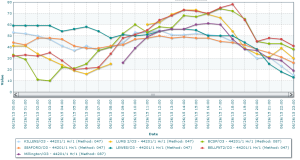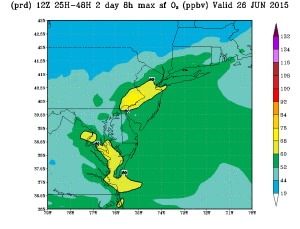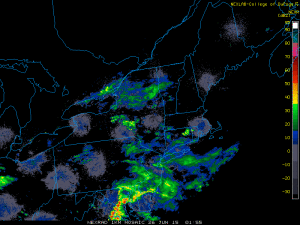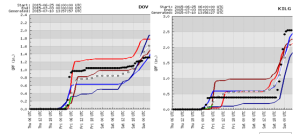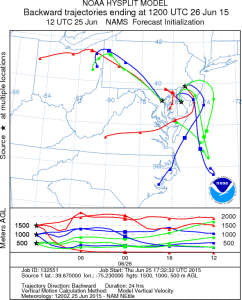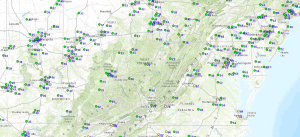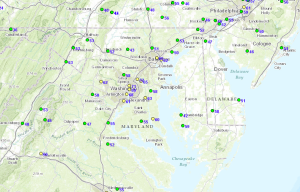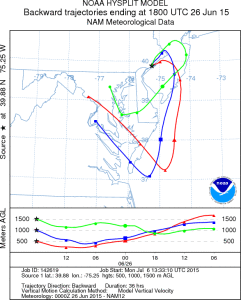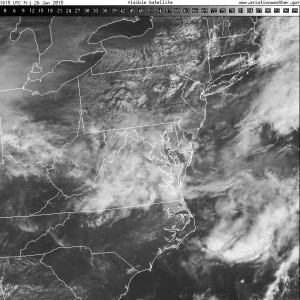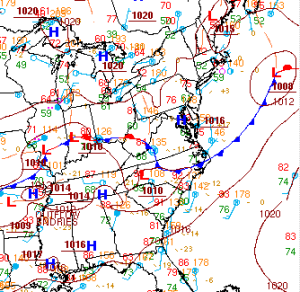Medium Range Air Quality Outlook
Mid-Atlantic Region
Issued: Tuesday, July 21, 2015
Valid: July 22 – 26, 2015 (Wednesday – Sunday)
Summary:
Cleaner and drier air will filter into the mid-Atlantic in the wake of a cold front passing through the region today. This new air mass will limit ozone and PM2.5 to the Good range for most of the region on Wednesday. Persistent high pressure will be the rule for the region beginning Thursday. Light winds and clear skies will increase the chances for USG ozone to Marginal for the weekend. As of now, clean back trajectories from Canada should cap ozone production, limiting higher chances for USG ozone.
Discussion:
The weather models are in very good consensus throughout the medium range period. The 06Z NAM, 00Z GFS, and 00Z ECMWF were consulted for this analysis. A large trough currently over the ON/QC border will continue to slowly move eastward, reaching the Atlantic Ocean on Saturday. This trough will pull a cold front through the Mid-Atlantic today. The cold front will sweep from the northwest to the southeast, reaching SC by 12Z Wednesday. Behind this cold front, an upper level ridge will begin to build into the region. The ridge axis will move eastward from the Plains on Wednesday to the western periphery of the Appalachians on Saturday, maintaining its strength as moves. A weak back door front will reach MD on Friday and dissipate further south Saturday. Weak pressure gradients will be the rule over the mid-Atlantic after the front dissipates.
A cold front will pass through the Mid-Atlantic today, sweeping from northwest to southeast. Scattered convection Tuesday evening across the northern and central Mid-Atlantic (NMA, CMA) will help clean out the atmosphere ahead of the cold front. A drier, cleaner air mass will filter in behind the front on Wednesday. Surface high pressure will also build in behind the front leading to clear skies and steady NW winds across most of the region. The new air mass will limit ozone to the Good/Moderate range with PM2.5 concentrations, currently below 10 ug/m3 upwind behind the front, limited to the Good range.
Surface high pressure will dominate the weather on Thursday, leading to clear skies and slowly diminishing winds throughout much of the region. Scattered shortwaves moving overhead in the southern Mid-Atlantic (SMA) will promote clouds and convection in NC on Thursday, limiting ozone production. Throughout the rest of the region, clear skies and light winds will enhance ozone production, but peak concentrations will be limited to the Good/Moderate threshold for another day. The air quality models are showing upper Good ozone for much of the region, with a few locations in eastern VA seeing Moderate ozone. PM2.5 concentrations should be limited to the Good range on Thursday due to the continuing low humidity with the exception of a few locations in NC and the western Mid-Atlantic.
Clear and calm conditions over the region on Friday and Saturday, allowing ozone to reach into the Moderate range. The main uncertainty will be the possibility of slightly cleaner air behind the weak back door front Friday in the NMA. Emissions on Friday will be more spread out in the afternoon, allowing for a higher potential for late afternoon ozone production. The air quality models are responding by showing Moderate ozone just to the west of the coast on Friday and in DC and Baltimore on Saturday. Clean back trajectories from Canada should prevent ozone from reaching the USG range on both Friday and Saturday. PM2.5 will also reach into the low Moderate range on Friday and Saturday due to light winds. Back trajectories originating in Canada and continuing low humidity will help limit concentrations from rising beyond the mid to upper Moderate range.
Surface high pressure will continue on Sunday, allowing clear skies and light winds to continue for much of the region. Lower Sunday precursor emission will limit ozone to the Moderate range. Increasing humidity and the light winds will help keep PM2.5 concentrations in the Moderate range. The precipitation forecast for Sunday is still uncertain as the fate of the approaching frontal boundaries is to be determined. There will likely be scattered clouds and precipitation in the NMA.
-DeBoe/Ryan



